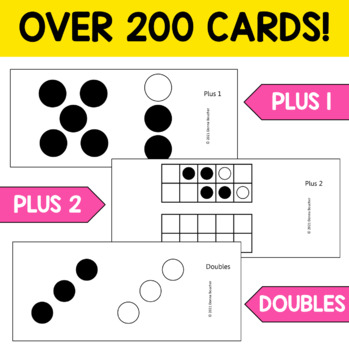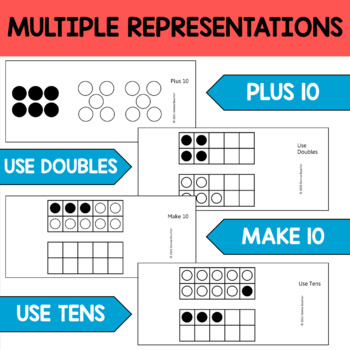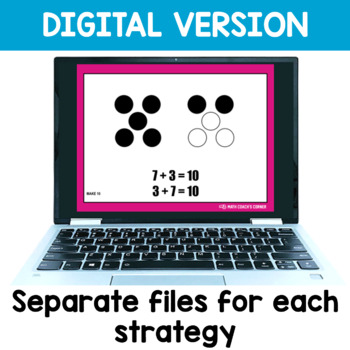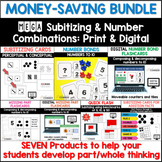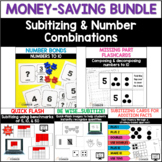Subitizing Cards for Addition Fact Strategies: Print and Digital
- PDF
- Google Apps™

What educators are saying
Also included in
- This mega bundle includes both print and digital versions of my best-selling number bonds, subitizing, and number combinations resources!These activities can be easily incorporated into your daily warm-up routine, small group instruction, whole group instruction, or math centers. Grab it for back-toPrice $30.60Original Price $38.25Save $7.65
- Subitizing and number combinations (number bonds) activities help students develop a strong sense of how numbers can be composed and decomposed. This bundle contains 5 of my most popular math resources for developing part/whole thinking with your Kindergarten, 1st, or 2nd-grade students. These actiPrice $21.00Original Price $26.25Save $5.25
Description
A MUST HAVE for the primary classroom! You'll never think of flashcards the same way again after using this set of dot cards to provide strategy-based, representational practice with addition and subtraction facts.
INCLUDES:
☀️ Over 200 individual cards with pictorial representations of seven different addition strategies
☀️ Digital files for use with Google Slides. One master file with all images and separate files with the images for each strategy!
☀️ Teacher instructions include explanations of common addition and subtraction strategies.
DOWNLOAD THE PREVIEW FOR TEACHING NOTES AND DESCRIPTIONS OF THE ACTIVITIES!
WHAT TEACHERS ARE SAYING...
⭐⭐⭐⭐⭐ "Subitizing cards are the best way I’ve found to improve number sense once the kids have lots of experience counting objects and understand one-to-one correspondence. My kindergarten students have made tremendous strides using these cards. We are not even using the term “addition “ at this point, but they know how to break a given sum into various groups (addends), form groups to make ten, etc. They are picking up many concepts just from repeated exposure to the cards and discussion, rather than my trying to “teach” the concept up front. This is a great resource! " Dianne D.
⭐⭐⭐⭐⭐ "This was such a time saver for me during our distance learning. My students loved the activities. Thank you so much!" Kelli C.
⭐⭐⭐⭐⭐ "Clever format and very helpful for kids to see the relationship between addition and subtraction! Thank you for sharing your talents!" Kathy D.
▶▶▶▶▶ Be sure to Leave a Review in "Your Purchases" on your dashboard to earn free credits good toward the purchase of future products!
YOU MIGHT ALSO LIKE…
✅Subitizing Cards, Perceptual & Conceptual: Print and Digital
✅Number Combinations Flash Cards with Missing Parts Bundle: Print and Digital
✅Teen Numbers - Reading, Writing, Comparing, and Ordering
STANDARDS ALIGNMENT
TEKS MA.K.2.I—Compose and decompose numbers up to 10 with objects and pictures.
TEKS MA.1.3.C—Compose 10 with two or more addends with and without concrete objects.
TEKS MA.1.3.D—Apply basic fact strategies to add and subtract within 20, including making 10 and decomposing a number leading to a 10.
TEKS MA.1.3.E—Explain strategies used to solve addition and subtraction problems up to 20 using spoken words, objects, pictorial models, and number sentences.
TEKS MA.2.4.A—Recall basic facts to add and subtract within 20 with automaticity.
CCSS K.OA.A.3—Decompose numbers less than or equal to 10 into pairs in more than one way, e.g., by using objects or drawings, and record each decomposition by a drawing or equation.
CCSS K.OA.A.4—For any number from 1 to 9, find the number that makes 10 when added to the given number, e.g., by using objects or drawings, and record the answer with a drawing or equation.
CCSS K.OA.A.5—Fluently add and subtract within 5.
CCSS 1.OA.C.6—Add and subtract within 20, demonstrating fluency for addition and subtraction within 10.
CCSS 2.OA.B.2—Fluently add and subtract within 20 using mental strategies. By end of Grade 2, know from memory all sums of two one-digit numbers.
CONNECT WITH MATH COACH'S CORNER
Be sure to follow my TpT store by clicking on ‘Follow Me’ next to my Seller picture to receive notifications of new products and upcoming sales. Visit my blog for K-5 math tips and freebies you can use tomorrow in your classroom. You can also find me on Facebook and Twitter.
TERMS OF USE
Copyright © Math Coach's Corner.
For personal and single-classroom use only.
To share this resource with friends or colleagues, please purchase additional licenses.


